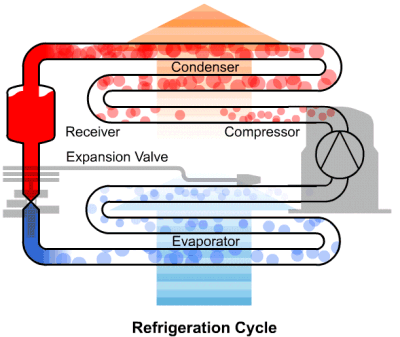Processors On The Rocks: Asetek's VapoChill
The 'Expansion Valve' And The 'Evaporator'
Now comes the actual cooling trick. A special expansion valve or a long capillary tube (as used by VapoChill or Kryotech) ensures a pressure delta between the receiver and the evaporator, so that the pressure lasting on the coolant is actually dropping once it reaches the evaporator. The acute pressure drop of the coolant makes it change its aggregate phase back to gaseous, which consumes a lot of energy. In this condition the coolant is moving through the evaporator. The energy required by the coolant to change its phase from liquid to gas can only be obtained by removing thermal energy (=heat) from its surrounding, which is of course the surrounding of the evaporator. In case of a sub-zero CPU-cooler the processor is providing this thermal energy. Taking heat away from the CPU is the same as what we call 'cooling'.
This part might be a bit hard to understand, so I've thought of some examples. I don't know if you've ever seen what happens if you open the valve of a fluid nitrogen tank to the normal air (remember Terminator II and the frozen T1000?). The gas streams out fast, it is very cold and you might find an actual buildup of frozen nitrogen around the leak. It is always a bit surprising, because the actual tank hadn't been cold at all. It's only the sudden pressure drop that causes the freezing temperature. Smokers who refill their gas-lighters may know a similar effect. The tip of the little refill tank gets very cold, especially when you are not able to connect it to the lighter properly and let the lighter-gas stream out to the open air. Finally I'd like to remind scuba divers, especially the ones who like to dive under freezing conditions. Those hardcore divers are most certainly aware of the fact that they require a very good regulator second stage, which does not produce ice. The logic is simple. In the second stage is always some water and the pressure drop of the breathing gas when you inhale could be enough to freeze the already cold water. Obviously this could be fatal.
The gaseous coolant is still pretty cold when it makes its way back to the compressor, to enter the cooling circle once more.
The Refrigeration Circle
In this excellent little picture from Danfoss you can see the hot and cold as well as the liquid and gaseous phases of the coolant as it moves through the refrigeration cycle.
The amount of cooling a refrigeration unit can provide is obviously depending on the flow of coolant through the system and the coolant-type itself. The more flow the more heat can be removed.
Get Tom's Hardware's best news and in-depth reviews, straight to your inbox.
Current page: The 'Expansion Valve' And The 'Evaporator'
Prev Page The Condenser Next Page The New VapoChill